While I’m tempted to make the case that my family’s Wise line goes all the way back to Colonel John Wise (1617-1695), who is thought to have arrived in the Virginia Colony from England in 1635, I think it’s probably more likely that the first Wise in my family to step foot in America was Richard Wise (1654-1732), who settled in St. Mary’s County, Maryland. Actually, I’m almost certain of it, as the line is relatively easy to trace back to him, given that my ancestors stayed put in St. Mary’s County, around the town of Leonardtown, for four generations. It wasn’t until my great, great, great, great, great grandfather, Clark Wise, left Maryland for Culpeper, Virginia, that things get a little more difficult to follow. And that’s how I’ve been spending my nights of late, attempting to trace things backward and forward from Clark Wise, who is yet another of my ancestors to have apparently fought in the Revolutionary War, and trying to figure out how it was that he came to relocate 80-some miles to the west of Leonardtown, to Culpeper. I’d originally thought it might have something to do with his having fought in the Revolutionary War. I’d thought, perhaps, he might have received a land bounty in return for his three years of service in the 11th Virginia Regiment. Now, though, I’m thinking that he relocated to Culpeper prior to the war.
As you may recall, it was a land bounty earned by my ancestor David Avery after his service in the War of 1812 that brought another line of my family west to Schuyler, Illinois in 1817, so I’d thought that something similar may have happened here. There were, after all, bounty land warrants given out after the Revolutionary War. There are a few things, however, that make me think that’s not the case here. First, Culpeper, which was founded in 1749, was already pretty well established by the time the Revolutionary War started, so it’s doubtful that land there would be given to veterans of the war. [note: A 17 year old George Washington was commissioned to survey and plot both the Town and County of Culpeper in 1749.] And most of the post-Revolutionary War land bounties that I’ve read about were in Ohio and Kentucky, which were just then opening up to settlement by non-native Americans. Second, I haven’t been able to find hard evidence of it, but some of Clark’s descendants seem to think that his first child, Margret, was born in Culpeper prior to the war. And, if that’s the case, obviously he would have already been in Culpeper before joining the revolution. And, third, and most importantly, we know from his Revolutionary War pay stubs that he fought in the 11th Virginia Regiment company of Captain Gabriel Long, who also haled from Culpeper, and, for what it’s worth, had a reputation as someone who was more than willing to kill British officers. So I think it’s probably the case that Clark Wise was in Culpeper prior to the Revolutionary War, and that’s where he decided to join Long’s company. [I’ve seen it noted that Long was also known to have “scalped” the English that he killed.]
And, yes, for what it’s worth, I think I’ve got pretty good evidence that particular relative of mine – Clark Wise – served in the Revolutionary War. I’ll get into it more in a minute, but, here, before too many of you lose interest, are a few of those Continental Army pay stubs that I just mentioned. As you can see, he served in the Virginia 11th Regiment, known as “Morgan’s Rifles,” under the command of Colonel Daniel Morgan. His company, within the regiment, as I mentioned earlier, was commanded by the storied marksman Captain Gabriel Long. [The Virginia 11th, along with the 3rd Virginia, the 7th Virginia, and the 15th Virginia, comprised the brigade of Brigadier General William Woodford. The Woodford Brigade, in turn, was one of three, along with the Scott’s Brigade and the North Carolina Brigade, under Major General Marquis de Lafayette, in what was known as Lafayette’s Division. Lafayette, by the way, when he was invited back to the United States by President James Monroe to tour the country in celebration of the 50th anniversary of the revolution, as the only living general of that war, visited Gabriel Long and the living members of the Virginia 11th on August 16, 1825. Clark Wise, however, didn’t make it that long. He had died some eight years earlier, in 1817.]
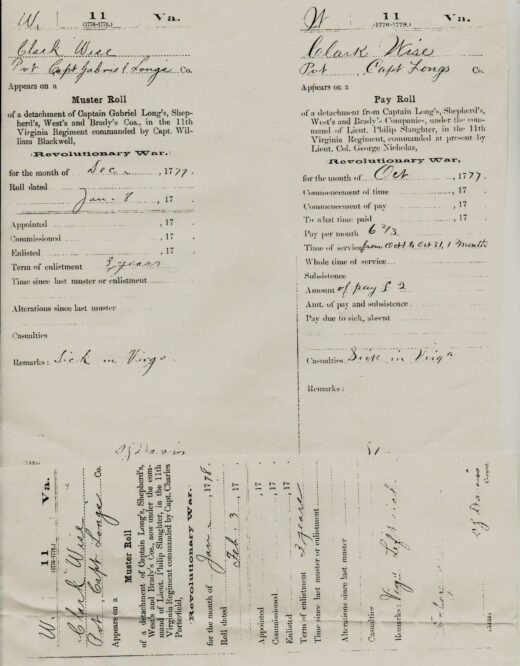
[A higher resolution image of the above can be found here.]
I’ll get back to the Revolutionary War in a minute, but first I’m going to trace the familial line back to Clark Wise… As you’ll recall, when we left off, I’d traced my ancestry back to Jefferson Davis Wise (1861–1937), the father of my great grandmother, Minnie Wise Florian. So, let’s pick things up there.
We know from the 1937 death certificate of Jefferson Davis Wise that he was born in Owen County, Kentucky to John Wise and Matilda Gill Wise. This is not only corroborated by his 1926 marriage certificate to his third wife, but by the 1870 census that shows a 9 year old “Jeff D Wise” living in Monterey, Kentucky, with his parents, John and Matilda Wise. [My great grandmother was the fourth of four children had by Jefferson Davis Wise and his first wife, Lavina Tipton (1850-1897), a fact that I just had confirmed again thanks to a family tree that was coincidentally mailed to my great grandmother by a relative the day after she passed away in 1981. While she, obviously, never received it, my aunt had the foresight to save the letter, and just emailed me a a copy.]
OK, so this is the only known photo of Jefferson Davis Wise, my great, great grandfather. That’s my grandmother’s handwriting at the bottom, and the people in the photo, from left to right, are Jefferson Davis Wise, Minnie Wise Florian (his daughter and my great grandmother), and Wythe Thomas Wise (another of the four children had by Lavina Tipton Wise and Jefferson Davis Wise).
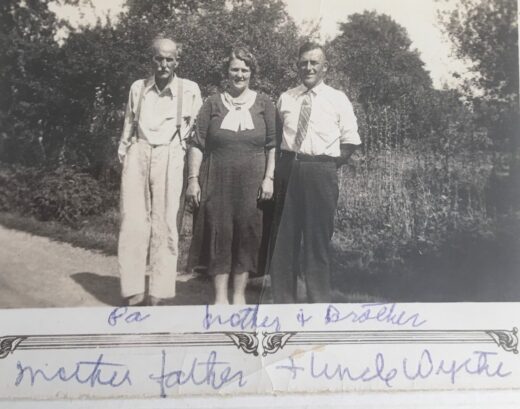
So, the next person in the Wise line, as we work our way backward through time, would be John Anderson Wise (1823-1893), the father of my great, great grandfather, Jefferson Davis Wise. It looks as though John Anderson Wise was born in Virginia on March 8, 1823, and moved to Kentucky at a relatively young age with his family. The first sign I can find of him in Kentucky, however, is on the 1850 census for Franklin, Kentucky, which encompasses Frankfort, and the surrounding countryside, right up to White Sulpher, Stamping Ground, and other places I remember talking with my great grandparents about. This census document is a bit confusing, as it doesn’t list Jefferson Davis Wise, who would have been 9 or 10 at the time, as having been living with them, but we know from his death certificate, which I linked to above, that John Wise and Matilda Gill Wise were his parents, and that he was born in Kentucky. And, this, I should add, is also the John Anderson Wise who we believe fought on the side of the Union during the Civil War, in the 14th Regiment of the Kentucky Cavalry, but I’ll come back to that at a later date. For now, I just want to demonstrate that Jefferson “Jeff” Davis Wise was the son of John Anderson Wise and Matilda Gill Wise, and, thankfully, someone in the Gill family posted an old family tree to a genealogy site which does that. Here’s the detail about their 11 children.

So, between this family tree, and the fact that “Jeff” Wise’s parents are listed as John and Matilda Wise on his death certificate, I feel pretty confident about that connection, especially seeing as how we have evidence of them all living in close proximity to one another in this area of Kentucky. The next step back, however, takes us to Virginia, which is a little more complicated.
I believe the father of John Anderson Wise was William D. Wise (1783-1872), who appears to have been born in Culpeper, Virginia on October 14, 1783. And I believe his mother was Lucinda Etherton Wise (1794-1829), who was also born in Culpeper. Among the reasons I feel comfortable making this claim is the fact that I’ve found a document detailing how John A. Wise and Matilda Gill were just one set of two Wise-Gill matches in their generation, with the other being Mary Wise and John Gill. Here’s the document, which shows William and Lucinda as the parents of both John and Mary.
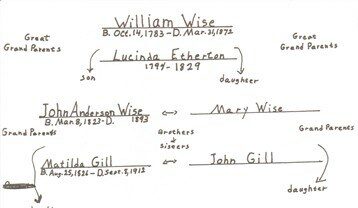
In addition, we have the will of William Wise, which lists John among his sons.
As for when the Wise family came to Kentucky from Virginia, it must have been prior to August 11, 1835, when we see evidence that William Wise married his second wife, Julia Long, in Franklin County, Kentucky. John Anderson Wise would have been about 12 at the time of the wedding. And, for what it’s worth, I also have evidence of William Wise’s 1815 marriage to Lucinda Etherton, my great, great, great, great grandmother, who passed in 1829, in Culpeper… So it’s looking as though the family migrated from Culpeper to Kentucky between 1829 and 1835.
So, if all of that holds up, it brings us to Clark Wise, the Revolutionary War veteran I mentioned at the beginning of this post, the man who I believe to be the father of William Wise, and my great, great, great, great, great grandfather. As you can see in this old Wise family tree, he’s listed as the father of the William Wise who married Lucy (Lucinda) Etherton. [I have no idea who authored this family tree, but, as it agrees with my research, I think it’s likely correct.]

OK, so I’m pretty sure that I’m a descendant of Clark Wise, who, as noted above, fought in the Revolutionary War, as part of the Virginia 11th. I’d like to take some pride in that, but, as I fear that he may also have been a slaveholder, I’m going to hold off a bit on celebrating the familial connection. But, as for his three years of service during the Revolutionary War, I imagine he was right in the thick of it. If you look at those pay stubs that I posted above, they show his service having taken place during the time that Washington was keeping his winter quarters at Valley Forge, which stretched from December 19, 1777 to June 19, 1778. And this is interesting because the Virginia 11th was stationed at Valley Forge during that period of time. Here’s a map that shows were Woodford’s Brigade would have been stationed.
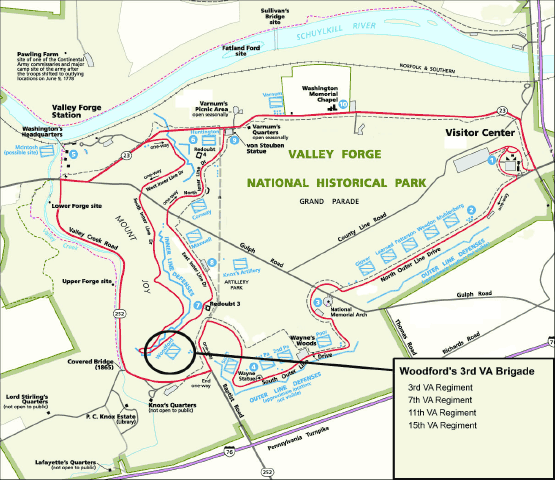
From what I’ve read, of the men who served in the Woodford Brigade at Valley Forge, 46 deserted, 113 died, and 380 were discharged. And, thankfully, Clark Wise was not one of those killed, as his son, my great, great, great, great grandfather, William Wise, was not born until 1783, well after the war. [When Morgan’s Brigade entered Valley Forge, only 81 of the 326 men assigned for duty were deemed to be “fit”. When they left Valley Forge, there were only 254 men then assigned for duty, and 152 of the were deemed fit. It’s also worth noting that, prior to their deployment to Valley Forge, the Virginia 11th also saw battle at the Siege of Boston, the Invasion of Canada, the Defense of Philadelphia, and in New York City, Trenton-Princeton, Northern New Jersey, and Philadelphia-Monmouth.]
For those of you who don’t know about that winter at Valley Forge, it was, by all accounts, hell on earth. Governor Morris of the Continental Congress referred to the men at Valley Forge as “an army of skeletons… naked, starved, sick and discouraged.” And, based on several of the pay stubs I’ve seen, Clark Wise from Culpeper was one of those who was sick. Washington wrote at the time that 2,898 men under his command at Valley Forge were “unfit for duty because they are bare foot and otherwise naked.” Men were literally starving to death and dying of exposure, and the Continental Congress, it would seem, was not coming to their aid. As Washington wrote at the time, “The congress has little feeling for the naked and distressed soldiers. I feel superabundantly for them, and from my soul pity those miseries, which it is neither in my power to relieve or prevent.” Thankfully, my ancestor survived the ordeal, and that’s why I’m here today. Many others weren’t so lucky.
Here’s his name on page 269 of the book Records of the Revolutionary War by J. T. McAllister.

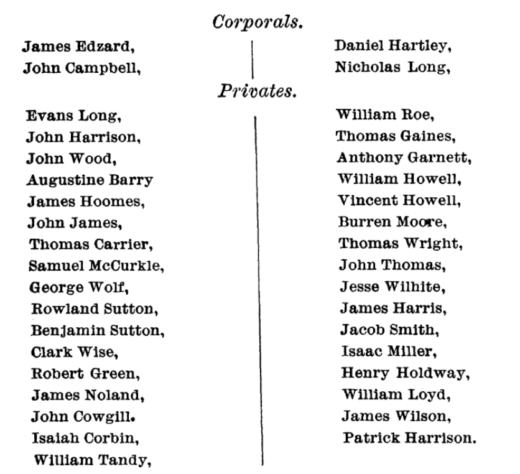
[note: Clark Wise would have been 24 years old on June 1, 1777.]
One more thing. While there’s not a lot written about Clark Wise, and his service during the war, I think it’s safe to say that, as one of just about 40 men in Gabriel Long’s company, he was likely involved in most everything that Long was involved in. So, with that in mind, here, from Wikipedia, is a little about Long’s service during the Revolutionary War.
…By the time Virginia began raising troops for service in the Continental Army, Long already had a rather distinguished service record and was renowned as one of the best riflemen in Virginia, so it was natural that when Daniel Morgan was recruiting his rifle battalion he chose Long as his senior captain. As later remarked by his men, Long was his “favourite captain and good friend”. Long also began recruiting his own men. He would reportedly draw a target, usually in the shape of a human nose, in the middle of a board and set it up at several hundred yards; those who shot the closest to the nose would be chosen for service in his unit. Long himself was known to have shot apples off of men’s heads at a considerable range, a practice which was said to have “wasted many apples”. He was also known to be accurate up to 300 yards with a target the size of an orange. His sons, Reuben and Solomon, also served in the Revolutionary War. Reuben served alongside his father in Daniel Morgan’s unit, and Solomon served in Lieutenant Colonel Francis Marion’s South Carolina Regiment.
Long traveled with Morgan to join George Washington’s army in its siege of Boston and was heavily involved in operations in the Boston area. Long’s fame and the fame of Morgan’s Rifles began to grow by early 1776. He became good friends with Washington and the Marquis de Lafayette, and was often sent out on detached services as an independent commander. He became famous for his willingness to kill officers and his hatred of Tories as well as his fondness of scalping the officers he killed. Long went on to serve with distinction as the vanguard of the army and to protect its encampments.
During the Battle of Trenton, Long was the first across the Delaware River and his company led the assault. It is believed that he may have been the mysterious marksman who killed Colonel Johann Rall. At the Battle of Princeton in January 1777, Long helped unite Sullivan’s and Washington’s columns by holding back the British and thus greatly contributed to the American victory.
Long was Captain of one of eight elite Companies of detached Provisional Riflemen commanded by Colonel Daniel Morgan and sent by George Washington in August of 1777 to defend Albany from British army under General John Burgoyne, who surrendered to the American forces at the end of the Battles of Saratoga in October 1777. When Washington settled into camp at Valley Forge, Long led his men as a detached company under his independent command who scouted and skirmished all around the camp and prevented the British from taking Washington’s army in such a vulnerable state. After the encampment at Valley Forge, he helped defend Philadelphia from an expected attack, and through his and others’ efforts it was repulsed.
At Millstone, New Jersey, while leading a detachment, he came across a column of British soldiers under Lord Cornwallis whose intentions were to draw Washington’s army out of its fortified position to an open area for a general engagement. Long, realizing this, raised the alarm and stood his ground, holding back the enemy while awaiting reinforcements which eventually completely drove out the British. Long once again saved Washington’s army and would continue to do so in the future.
So, yeah, it looks like I’m the direct descendant of a Revolutionary War sniper.












15 Comments
I have quite a few of his Revolutionary War pay stubs now, and some of them, like the ones above, say “sick”. Given what we know about the conditions at Valley Forge, I don’t doubt that he was sick, as most of the men were, but I’m curious that a few say “sick in Virginia”. Might it have been possible that he was so ill that he was sent back to Virginia at some point? Or are these perhaps references to his having been previously sick, while in Virginia?
I’m impressed with the depth and complexity of your research on this. I have considerable trouble just remembering the names of the few dozen living relatives I have.
How long do you imagine the imagined “patriots” who leave comments on this site would have lasted in Valley Forge with their QAnon militias?
Congratulations. Your ancestor is rolling in his grave about his descendant being a CIA tool.
Aloha , MM when the US Government of the 1st Republic of the Articles of Confederation created the Territories North and West of the Ohio River they were still revolutionary in outlook. They did several things that still define much of our reality. First they established that any new states created needed to be Democratic. 2nd it required the territory be surveyed from the Point of Origin to establish definitive land ownership. 3rd associated with 2 they established Townships made up of sections. 4th each Township was to set aside one section for the support of public education and one section for the maintenance of the Republics veterans. They also outlawed slavery. I take some comfort in knowing the egalitarian socialist origins of the mid-west.
The military land grants you mentioned were created for those original states that had no unexpropriated Indian or Tory land to use. Thus the original Cass corridor where Cleveland sits. Connecticut claimed that land for its veterans. It was resolving this dispute that caused the creation of the large military land grant area in Illinois. Of course most veterans sold their land grant rights to speculators who subsequently sold them to more recent immigrants.
In their defense they were CIA tools last week. This week they are Historians and part-time JazzCats.
Meant to say Case as in Case Western not Cass
By the way I think it is great that your daughter can join the DAR
https://www.dar.org/national-society/become-member
Isn’t genealogy fun!
I too can be a member of the DAR but I have no reason to be. My grandmother was a member though and I have a lot of the papers and documents she used to support her claim. Those were pretty helpful when doing my own research.
I found some really cool stuff when I went looking. I was tracing back the line of my paternal grandmother and because WASPS like to trace their roots, a lot of the research was already completed by other family members. I was able to trace a line back to Roger Williams, founder of Rhode Island which was pretty cool. Also cool was learning about my great great grandfather, Stephen Woodworth who was a signer of The Declaration of Sentiments (https://en.wikipedia.org/wiki/Declaration_of_Sentiments) an early feminist document! Also signed by Frederick Douglas and written by Elizabeth Cady Stanton! He also was a plaintiff in a US Supreme Court case and the stepfather and uncle to a well-known entomologist at UC Berkeley named Charles Woodworth. I got most of the info about Stephen Woodworth from a biography written about Charles.
Speaking for HW and myself, and our ancestors, I’d like it to be known that deserters are also worthy of our respect and admiration.
Erhh, deserters…That’s bad so HW and his ancestors must that! So weak.
Remember, HW, we are at war and everything our Government tells us will be propaganda.
By the way Epstein did not kill himself
I learned to play poker with pennies in Saint Mary’s County Maryland from my friend Kim’s grandpa whom we called Pappy. He had a small cabin on the water. We trapped crabs and swam in the bay. There were big black water snakes. They told us not to worry about them because they didn’t bite. But man they were as long as we were. I feel pretty sure the Chesapeake bay isn’t like that anymore. When I spent time in the swamps of East Texas and Louisiana they reminded me of St Mary’s, just bigger and meaner.
No one in my family fought with Washington. My PA family were Anabaptist (Brethren and Mennonite and Amish) and so pacifist. Most were theirs too because they signed a contract with England granting them land and religious freedom. I guess it was not clear if colonies would continue that protection at the time. They sold goods to soldiers on both sides. Because Swiss German…
Sharpshooters, as they were called, were seen as ungentlemanly by the British. This was the era of formations, marching and fighting in step and the like.
https://www.chesapeakebay.net/S=0/fieldguide/critter/northern_water_snake
One Trackback
[…] mother passed away when she was just four years old, and the stories I’d heard of her father, Jefferson Davis Wise, having abandoned her around that same time, for reasons that have never been clear to me? Well, at […]